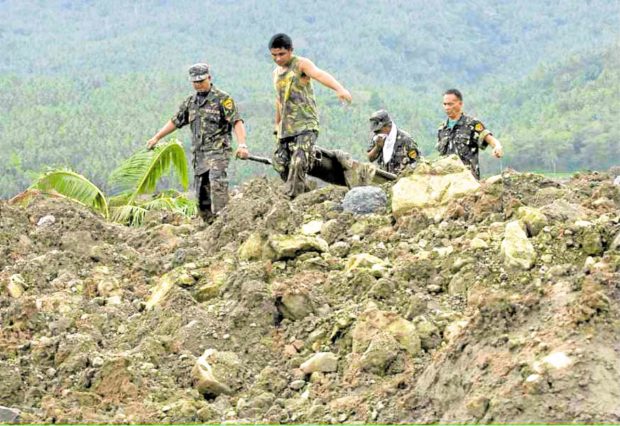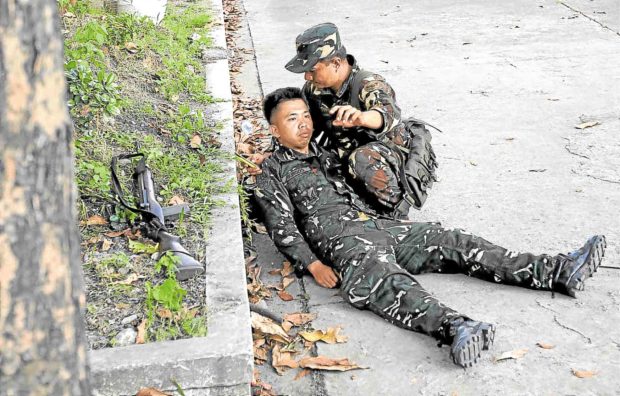When a picture is worth a thousand risks

HELP AT LAST An Army rescue team carrying cadavers from the mudslide in Guinsaugon, Southern Leyte, comes to Edwin Bacasmas’ aid after the Inquirer photographer sank into rainsoftened ground. —PHOTOS BY EDWIN BACASMAS
A day after the Feb. 17, 2006, Guinsaugon mudslide in St. Bernard, Southern Leyte, Inquirer photographer Edwin Bacasmas found himself chest deep in trouble.
He and Volt Contreras had been sent to cover the rain-induced mudslide that caused a whole section of a mountain to slide into the village of Guinsaugon below, carrying with it 1.2 billion cubic meters of mud and boulder. The thick and viscous mud covered 300 hectares of the barangay and killed 1,500 people in minutes.
“We had to hitch a ride in a military Huey chopper to get to Leyte from Cebu,” Bacasmas recalled. From the air, they saw the scope of the devastation, “malawak (extensive),” the photographer said.
Despite the risks and utter desolation of the landscape, Bacasmas decided to cross a river to get pictures of less accessible areas. That was how he got award-winning shots: by going a step further.
“The ground was soft because of the rains, but there were rocks I could step on so I wasn’t worried,” he recounted. As he scoped the area, taking shots as he went, Bacasmas suddenly found he couldn’t pull out his right foot from the mud. “I was wearing new Columbia sandals and was ready to leave (half the pair) in the mud but I couldn’t get it off!”
Article continues after this advertisementTo his horror, he found that the more he struggled to pull out his feet, the deeper he sank. “I started at mid-calf, then before I knew it, I was up to my chest in mud!” Bacasmas said.
Article continues after this advertisement“I knew I could die there because it was midafternoon, there were dark clouds gathering and a stiff breeze was blowing. The rains were coming back!,” he thought fearfully.
More rains could soften the thick mud still clinging to the mountain slopes, bringing it down to where Bacasmas was and sinking him even deeper. There was no one around, only the graying skies, the melting mountains, and the treacherous mud.
As if reading his thoughts, the cell phone in his pants’ pocket started vibrating. “The water must have gotten into it,” he said.
Suddenly, from behind a rise, Bacasmas spotted some five or six soldiers carrying cadavers on stretchers. He started yelling to get their attention while waving his arms that carried his cameras aloft.
They rushed down to him, put the cadavers on the ground, and held out a stretcher for him to hold on. With the soldiers pulling back the stretcher, Bacasmas worked his way out of the mud. It took about 20 minutes for him to finally emerge from the ground.
Later, as he washed himself off in a nearby stream, an ABS-CBN reporter also covering the calamity spotted him. “O, what happened to you?” he asked. Bacasmas told him, unaware that he was being filmed live all the while. That was how the Inquirer desk knew what happened. His boss then, chief photographer Ernie Sarmiento, wanted to do a story on the incident but he refrained. “Wag na, my mother might get worried,” said Bacasmas.
And well she should, considering that her son regularly, casually, waded into war zones.
In 2000 and without the Inquirer’s knowledge, Bacasmas embedded himself with the 1st Marine Brigade in then President Estrada’s all-out war against the Moro Islamic Liberation Front after the secessionist group held hundreds hostage in Kauswagan, Lanao del Norte.

STUNNED A sudden mortar blast left this soldier stunned and wounded during the Zamboanga
siege in 2013.
But among the many war stories he had covered, the photographer considers the Zamboanga siege in 2013 and his Jolo coverage after the 2008 kidnapping of broadcaster Ces Drilon most memorable.
“I had a close call both times,” he said.
Covering the Zamboanga siege had seemed a cinch, Bacasmas said.
The armed conflict between government forces and a faction of the Moro National Liberation Front (MNLF) loyal to its chair, Nur Misuari, erupted when the MNLF separatists attempted to raise the flag of the self-proclaimed Bangsamoro Republik at Zamboanga City Hall. The crisis lasted almost three weeks.
When he reached the city via habal-habal, Bacasmas said he dove right into the war zone without even bothering to drop off his stuff at the hotel. He found colleagues from other media hiding behind walls of abandoned buildings as gunfire zipped past. A soldier nearby gamely posed for pictures with Red Cross workers.
Suddenly there was mortar fire and an explosion. “I was eating some corn when I was suddenly flung against a wall. The soldier was killed and the Red Cross staff wounded. I couldn’t hear a thing for about a week,” the photographer said.
In Jolo, in the heels of the Drilon kidnapping by the Abu Sayyaf, Bacasmas found himself in a hotel with the other media crew, with two Marines guarding them. Three days into their stay, the Marines told them to stay put inside their room, they were just slipping out to ask for reinforcement. Several men were circling the hotel, they said, probably scouting for more kidnap victims. That same night, an APC (armed personnel carrier) took the media personnel from the hotel and into the military camp, where they stayed for the rest of their coverage, said Bacasmas, who has been with the Inquirer for 22 years.